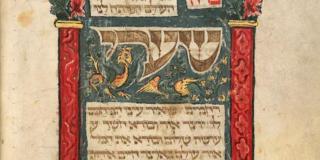
Samaritan Bible
Abraham ben Israel ha-Nasi, King of Israel (Scribe)
Samaritan Bible
Manuscript on vellum
Latin Kingdom of Jerusalem [Jamnia], 1232
The manuscript of the Samaritan Bible held at The New York Public Library is considered one of the oldest known and reputable Samaritan manuscripts in existence. It provides a unique glimpse into the text and script of the Samaritan Pentateuch during that time.
The Samaritan ethnic and religious group claims its origin from the Josephite tribes of northern Israel, who began to shape their identity after the split in the eighth century BCE between the northern and southern parts of the Kingdom of Israel. The Samaritans recognized only the Pentateuch (the Five Books of Moses) and used a distinctive Samaritan Hebrew script for their religious purposes. They consider Mount Gerizim near Nablus in the current West Bank as their holy site for worship.
The page on display demonstrates an example of the early Samaritan micrographic, which could also be described as a “geographical page.” The circle visible inside the page symbolizes Mount Gerizim, in recognition of its important role in the Samaritan religious tradition as well as its central geographical location for the Samaritan population. The lines that extend from the circle to the corners of the paragraph reinforce this symbolism.
The scribe of the manuscript identified himself as Abraham ben Israel ha-Nasi, who also served as the head of the Samaritan community at that time. He was born circa 1169-1170 into a prominent Samaritan family; his father was also a scribe and the head of their community. Both Abraham and his father called themselves “nesi bet Yisrael” (King of Israel). This particular Pentateuch would be the 74th that the prolific Abraham wrote. The manuscript remained in the family for generations, but was eventually sold to another owner. The Lenox Library, a forerunner to The New York Public Library, purchased it from W. Scott Watson, an American Presbyterian clergyman and missionary, in 1895.
The New York Public Library believes that this item is in the public domain under the laws of the United States, but did not make a determination as to its copyright status under the copyright laws of other countries. This item may not be in the public domain under the laws of other countries. Though not required, if you want to credit us as the source, please use the following statement, "From The New York Public Library," and provide a link back to the item on our Digital Collections site. Doing so helps us track how our collection is used and helps justify freely releasing even more content in the future.






